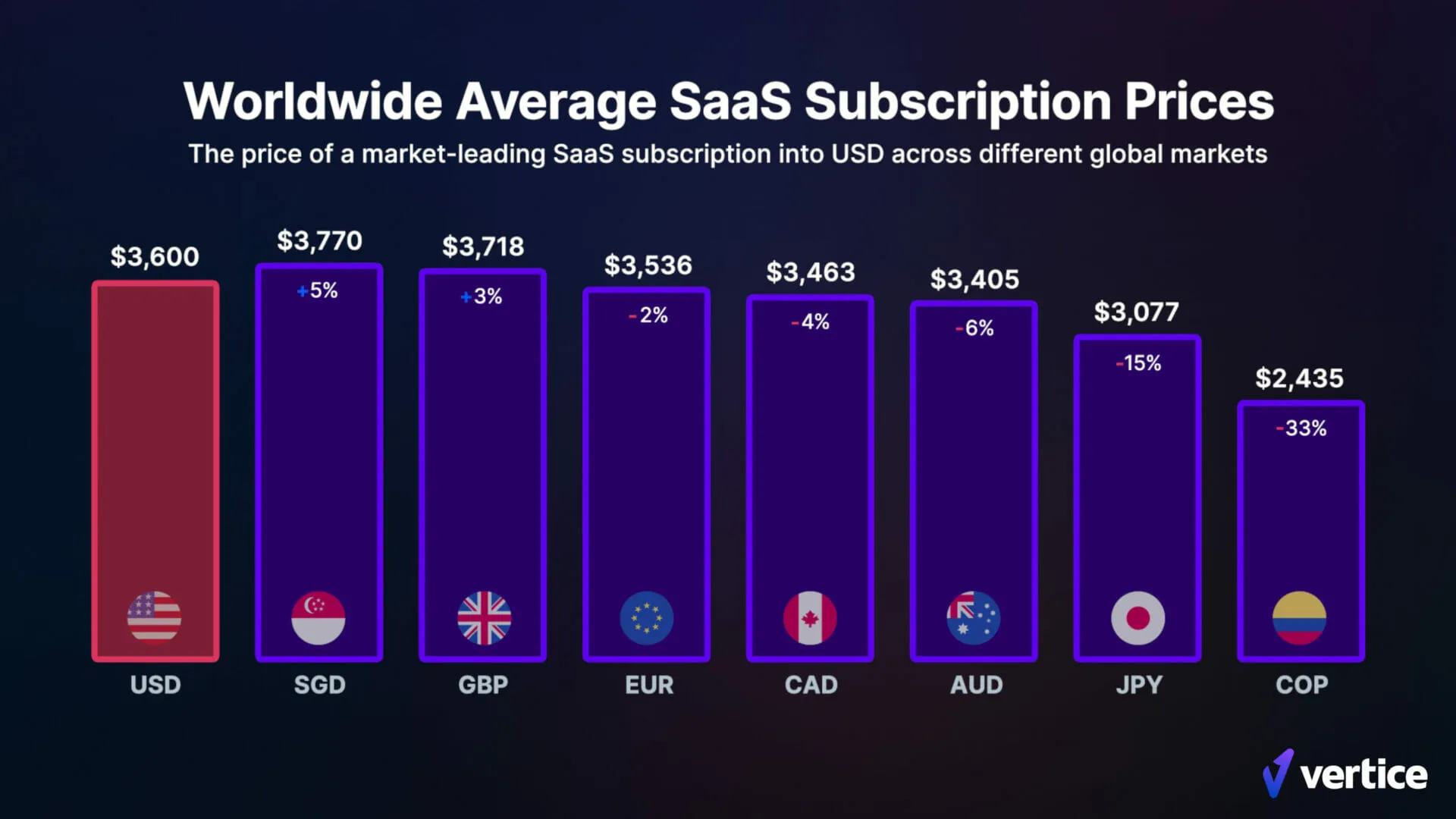



Take a self-guided tour of the platform.
Optimize every dollar your team spends on SaaS
See why Vertice is trusted by top procurement leaders.
CFO-focused strategies for reducing preventable spend and unlocking maximum value from software investments.



With costs continuing to rise, finance leaders are under pressure to reduce spend – especially in software procurement, which now accounts for $1 in every $8 of organizational expenditure.
While common strategies like license optimization, price benchmarking, and SaaS Spend Management helps, one often overlooked method is leveraging foreign currency transactions.
By taking advantage of currency drift, finance teams can purchase SaaS tools at more favorable exchange rates.
But what exactly is currency drift, and how can it help reduce software costs?
Here’s what finance leaders need to know before paying for SaaS in a foreign currency.
What is currency drift – and how can finance leaders use it to reduce SaaS spend?
While SaaS price hikes often make headlines, the majority of vendors don't update their pricing frequently enough to keep pace with global currency fluctuations.
For finance leaders, this creates a valuable cost-saving opportunity.
This phenomenon – known as currency drift – occurs when exchange rates shift, altering the relative value of different currencies. When foreign currency weaken against your own, the cost of software priced in that currency may become significantly cheaper.
By identifying and acting on these pricing discrepancies, finance teams can apply arbitrage pricing strategies to secure lower rates on SaaS subscriptions – without compromising the tools their business relies on.
Can I pay for software in a different currency?
In short, yes.
Even if your business doesn't routinely operate in multiple currencies, it's often possible to purchase or renew software in a foreign currency. While there are practical and financial considerations – such as payment methods and potential fees – doing so can unlock significant savings.
By leveraging currency drift and applying pricing arbitrage, finance teams can reduce SaaS costs by paying in currencies where the exchange rate works in their favor.
Here’s how it works in practice.
A real example of currency arbitrage in SaaS procurement
Many global SaaS platforms display pricing in multiple currencies – sometimes offering as many as seven or more options. In one example, the enterprise plan of a leading tool is priced at $3,600 USD/month. However, when comparing the equivalent pricing in other currencies, the cost varies significantly.

At the time of writing, a U.S. company would actually pay more by purchasing in USD than in almost any other currency – except for GBP and SGD. The most significant difference appears with the Colombian Peso, where the listed price of COL$10,800,000 equates to $2,437 USD – a saving of more than $1,000/month. Similarly, paying in Japanese Yen offers a saving of over $500.
These discrepancies illustrate how finance teams can unlock substantial savings simply by choosing the right billing currency.
What finance teams should consider before purchasing software in a different currency
If your business already holds a bank account in the currency you intend to use, paying for SaaS in that currency is typically straightforward – it becomes a same-currency transaction with minimal operational impact.
However, if you're not set up for foreign currency payments, there are important cost considerations to factor in, including fees, exchange rates, and payment methods. Additionally, controlling maverick spend – unauthorized purchases – is critical to ensure these cost-saving strategies aren’t undermined by untracked expenses.”
To help finance teams make informed decisions, we spoke with experts at global payments provider Airwallex about how to assess the financial viability of cross-currency SaaS payments.
What considerations should be taken into account when deciding to pay for a SaaS subscription in a foreign currency?
Avoid the conversion trap! When businesses are receiving funds from clients abroad or spending overseas, they need to be mindful not to fall into conversion traps that can erode their precious margins.
A domestic bank may charge unnecessary fees and cause delays when sending funds internationally. It’s wise to check how much a SWIFT payment will cost for each payment and how much this would add up to over the year. Similarly, if you’re using corporate cards, be sure to check what conversion rates will be used and if there are additional fees for spending in foreign currencies.Before signing up to a software subscription in a foreign currency, any business should ultimately ask itself:
- What bank accounts do I hold overseas to make the payment?
- What method of payment do they prefer?
- What costs will be incurred for each transaction?
Your global payments and financial infrastructure should be able to answer each of those questions and, ideally, you’ll want it all from one provider.
What costs are typically incurred when making payments in a foreign currency?
Banks will typically charge both a cross-border fee and a conversion fee when sending money internationally. Quite often, overseas payments will rely on the SWIFT network which can be costly and result in unnecessary delays, with funds often in limbo for up to 4-5 days.
You should also look out for the foreign exchange rate, conversion fee, and/or the cross-border fee (which can be anything from 1-3%) being offered when comparing providers. A word of caution, the conversion fee is often hidden within the transactions, so you lose visibility on the markup – some quick math will tell you what the markup is though. At Airwallex, we make a point to list the conversion fee and we don’t charge a cross-border fee. Furthermore, our cards are multi-currency so they draw from the correct currency inside your wallet, meaning you don’t have to pay the conversion fee unnecessarily.
Beyond currency drift: Tackling SaaS wastage to optimize spend
While leveraging currency drift can help reduce SaaS spend, companies can only achieve meaningful cost savings once they've tackled a major – and often overlooked – financial drain: SaaS wastage.
Our data shows that 21% of SaaS tools are entirely unused within the average organization, with a further 45% underutilized . For many, the financial impact is huge – more than $1.6M annually for companies with over 500 employees.
Optimizing currency strategies alone isn’t enough; companies must also focus on eliminating internal inefficiencies to truly maximize the value of their SaaS investments.
.webp)















